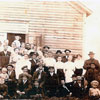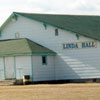Linda Hall
 At one point, the Linda Hall district, which consisted of 45 families living immediately south of Stettler and 15 more west of Big Valley, was recognized as the largest Estonian settlement in Canada. With so many Estonians residing here, the Reverend John Sillak made frequent trips to the community to preside over baptisms, weddings, and funerals.
At one point, the Linda Hall district, which consisted of 45 families living immediately south of Stettler and 15 more west of Big Valley, was recognized as the largest Estonian settlement in Canada. With so many Estonians residing here, the Reverend John Sillak made frequent trips to the community to preside over baptisms, weddings, and funerals.
Between 1909 and 1911, work began on the construction of a community hall. Members of the Estonian community aptly named the structure Linda Hall in honour of the famed Estonian mythological character. Linda Hall was officially opened 24 June 1911. The festivities were marked by a festive supper and lively dance (more on Linda Hall in the Cultural Life section). The Estonians who helped build the hall believed that its location represented the very center of all of the Estonian settlements located south of Stettler and north of Big Valley. An Estonian Men's Club, largely organized by Magnus Tipman, was soon established. Initially, there were 28 members eager to participate in social events and deliberate on current events.
 Like other rural communities across Alberta during the post-industrial era, younger generations within the farming community often migrated to large centres in search of a higher education or technical or professional employment-all in an effort to attain a better paying job. Alberta's Estonian communities saw much of the younger generation move to Calgary and Edmonton or to other places beyond Alberta's borders. An exception to this trend is the Hennel family whose farm in the Linda Hall district was recently recognized as a Century Farm, a farming operation that has stayed in the same family for a monumental 100 years. The Hennels continue to represent the tradition of cooperation and teamwork many Estonian families displayed when they first settled south of Stettler over 100 years ago.
Like other rural communities across Alberta during the post-industrial era, younger generations within the farming community often migrated to large centres in search of a higher education or technical or professional employment-all in an effort to attain a better paying job. Alberta's Estonian communities saw much of the younger generation move to Calgary and Edmonton or to other places beyond Alberta's borders. An exception to this trend is the Hennel family whose farm in the Linda Hall district was recently recognized as a Century Farm, a farming operation that has stayed in the same family for a monumental 100 years. The Hennels continue to represent the tradition of cooperation and teamwork many Estonian families displayed when they first settled south of Stettler over 100 years ago.








